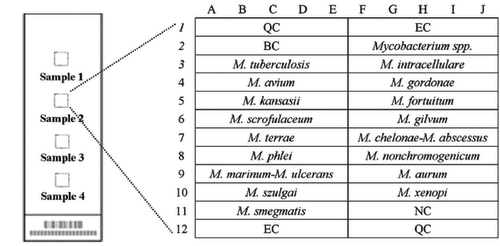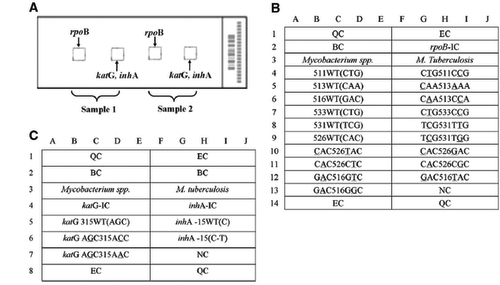Figures & data
Figure 1 Schematic diagram of the DNA probe array for different Mycobacterium species. Seventeen oligonucleotide probes that hybridize to species-specific sequence regions of the 16S rRNA gene were chosen for identification of different Mycobacterium species. All probes were immobilized horizontally five times.

Figure 2 Schematic diagram of the DNA probe array for rpoB, katG and inhA detection. (A) The biochip contains two microarrays, and two specimens can be analyzed in parallel; in each array, one subarray is for RMP, and the other is for INH. (B) Six rpoB wild-type probes and thirteen mutation-type probes were designed for the detection of RMP resistance. (C) For the detection of INH resistance, one probe covers the wild-type codon 315 of katG and two mutation-type probes for the same region, and one wild-type probe and one mutation-type probe are used to detect the inhA promoter region. All probes were immobilized horizontally five times. QC, quality controls; EC, external controls; BC, blank controls; NC, negative controls; IC, internal controls; WT, wild type.

Figure 3 Hybridization pattern of spinal tuberculosis specimens obtained with the DNA probe. (A) Hybridization patterns on the gene chip used to identify M. tuberculosis strains (white frame). (B) RMP resistance detected by the presence of the rpoB 531 (TCG->TTG) mutation; the hybridization signal generated by probe TCG531TTG (solid rectangle) is more intense than that generated by the corresponding wild-type probe (dashed rectangle). (C) RMP resistance detected by the presence of the rpoB 516 (GAC->GTC) mutation; the hybridization signal generated by probe GAC516GTC (solid rectangle) is more intense than that generated by the corresponding wild-type probe (dashed rectangle). (D and E) INH resistance tested by the presence of the katG 315 (AGC->ACC) mutation; the hybridization signals generated by the katG probe AGC315ACC (solid rectangles) are more intense than those generated by the corresponding wild-type probe (dashed rectangles). (E) INH resistance detected by the presence of the inhA-15 C-T mutation; the hybridization signal generated by the inhA 15C→T probe (solid rectangle is higher than that generated by the corresponding wild-type probe (dashed rectangle). (Figures, , were from a previous publication by our team that appeared in BMC Infectious Diseases 2012).

Table 1 Demographic and clinical characteristics of patients tested using conventional culture methods or molecular technology
Table 2 Therapeutic outcome of MDR-TB patients diagnosed using conventional culture and molecular diagnosis technology (n=92)
Table 3 Specialized control measures for contagion
Table 4 Complications (n=30)
